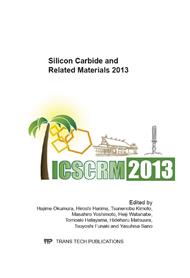p.214
p.218
p.222
p.226
p.230
p.234
p.238
p.243
p.247
The Influence of the Carbonization Mechanisms on the Crystalline Quality of the Carbonization Layer for Heteroepitaxial Growth of 3C-SiC
Abstract:
The carbonized layer for a buffer layer strongly influences the crystalline quality of the 3C-SiC epitaxial films on the Si substrates. The growth mechanism of the carbonized layer strongly depended on the process conditions. The surface of silicon substrate was carbonized under the pressure of 7.8 × 10-3 Pa or 7.8 × 10-2 Pa in this research. Under the relatively low pressure of 7.8 × 10-3 Pa, the carbonized layer was grown by the epitaxial mechanism. The crystal axis of the carbonized layer grown under this pressure was confirmed to coincide with the crystal axis of the Si substrate from the results of the selected area electron diffraction (SAED) analysis. Under the relatively high pressure condition of 7.8 × 10-2 Pa, the carbonized layer was grown by the diffusion mechanism. The result of the SAED pattern and the XTEM image indicated that this layer consisted of small grainy crystals and their crystal axes inclined against the growth direction. It was confirmed that the crystalline quality of the SiC film deposited on the carbonized layer grown by the epitaxial mechanism is better than that deposited on the layer grown by the diffusion mechanism.
Info:
Periodical:
Pages:
230-233
Citation:
Online since:
February 2014
Authors:
Price:
Сopyright:
© 2014 Trans Tech Publications Ltd. All Rights Reserved
Share:
Citation:


